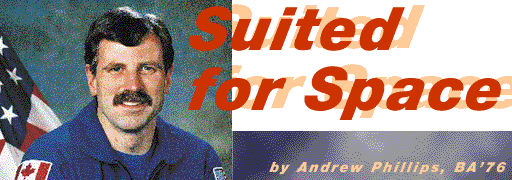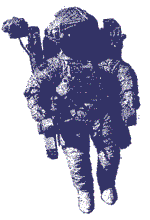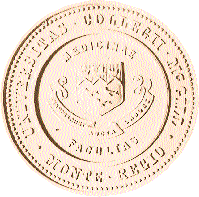
They've squeezed Dave Williams into a cooling suit, a skin-tight white outfit laced with a network of plastic tubing. He's lain on his back and wriggled into his space suit like a four-year-old getting ready to go out and play in the snow. Then he's clamped on the helmet and the big clumsy gloves, and watched as they placed weights in little slots all over the suit. Now he's immersed in six and one-half million gallons of water, pulling himself hand-over-hand through a full-scale mockup of the payload bay of a space shuttle resting on the bottom of a 40-foot-deep tank. Divers equipped with underwater video cameras are tracking his every move, and his words are transmitted through a cable into a control booth high above the tank as he uses the buoyancy of the water to simulate the weightlessness of space.
 "Ingressing the rear hatch," he intones in the mechanical space-talk that passes for normal language here at the Johnson Space Center, NASA's sprawling headquarters on the southern outskirts of Houston. Just another day at the office for Canada's newest astronaut. Not many people know what they will be doing at a precise moment several months in the future, but Dave Williams has known for at least that long exactly what will be happening to him at 2:19 p.m. EST on April 16, 1998. He and six fellow crew members will be strapped into the space shuttle Columbia on top of a rocket booster at Cape Canaveral, Fla. Minutes after lift-off, according to plan, they will be 150 nautical miles above Earth, orbiting the globe at a speed of 17,500 miles per hour -- or once every 90 minutes. They will stay there for 16 days, performing 26 experiments as part of the Neurolab mission that will study the effects of zero gravity on the nervous systems of humans and animals. Neurolab, says Williams, is designed to explore "the last two frontiers -- outer space and inner space." "Ingressing the rear hatch," he intones in the mechanical space-talk that passes for normal language here at the Johnson Space Center, NASA's sprawling headquarters on the southern outskirts of Houston. Just another day at the office for Canada's newest astronaut. Not many people know what they will be doing at a precise moment several months in the future, but Dave Williams has known for at least that long exactly what will be happening to him at 2:19 p.m. EST on April 16, 1998. He and six fellow crew members will be strapped into the space shuttle Columbia on top of a rocket booster at Cape Canaveral, Fla. Minutes after lift-off, according to plan, they will be 150 nautical miles above Earth, orbiting the globe at a speed of 17,500 miles per hour -- or once every 90 minutes. They will stay there for 16 days, performing 26 experiments as part of the Neurolab mission that will study the effects of zero gravity on the nervous systems of humans and animals. Neurolab, says Williams, is designed to explore "the last two frontiers -- outer space and inner space."
Williams will be the seventh Canadian in space, following in the footsteps of such pioneers as Marc Garneau, Roberta Bondar and fellow McGill graduate Robert Thirsk, MD'82. He seems cut out for the part: with his straightforward manner and generous moustache, he looks as though he might be a Mountie if he weren't an astronaut. In fact, he is a doctor, a specialist in emergency medicine with a list of other skills long enough to make most people feel weary just hearing about them: flying, scuba diving, hiking, sailing, kayaking, canoeing and skiing.
Now, at 43, his title is mission specialist and he is a career astronaut with NASA, in line for other missions once Neurolab returns to Earth. Next on the horizon is the international space station, the permanently occupied orbiting laboratory that is due to be completed by 2002 as a joint project of the United States, Russia, Europe, Japan and Canada.
 To hear Williams tell it, as he relaxes at home in suburban Houston, he's been a space nut ever since he was a kid growing up in Pointe-Claire, Quebec, in the 1960s. Like millions of others, he watched from afar as the pioneering astronauts of the Mercury, Gemini and Apollo programs went from the first tentative orbits of the Earth to landing on the moon within a few short years. He collected space cards the way other kids snapped up baseball cards, and watched the Golden Hawks stunt flyers performing at St. Hubert on the South Shore. But it looked like an impossible dream: "I was very excited by space. But it seemed that all the flying was being done by Americans and Russians. There didn't seem to be any way for a Canadian kid to get involved." Instead, he went for the next best thing: he took up scuba diving at a Pointe-Claire pool at age 13, and worked as a lifeguard to put himself through a science degree and medical school at McGill. To hear Williams tell it, as he relaxes at home in suburban Houston, he's been a space nut ever since he was a kid growing up in Pointe-Claire, Quebec, in the 1960s. Like millions of others, he watched from afar as the pioneering astronauts of the Mercury, Gemini and Apollo programs went from the first tentative orbits of the Earth to landing on the moon within a few short years. He collected space cards the way other kids snapped up baseball cards, and watched the Golden Hawks stunt flyers performing at St. Hubert on the South Shore. But it looked like an impossible dream: "I was very excited by space. But it seemed that all the flying was being done by Americans and Russians. There didn't seem to be any way for a Canadian kid to get involved." Instead, he went for the next best thing: he took up scuba diving at a Pointe-Claire pool at age 13, and worked as a lifeguard to put himself through a science degree and medical school at McGill.
Williams graduated in 1983, along the way winning the Wood Gold Medal for outstanding clinical skills. Dr. Dale Dauphinee, associate dean of medicine at the time and now executive director of the Medical Council of Canada, re-members that Williams made time in the middle of his medical studies to help him to start a CPR course for a boy scout troop in Westmount. He's not surprised that his one-time student has gone so far.
"Dave had an incredible serenity about him," Dauphinee says now. "He didn't have the highest marks, but he was able to balance so many things at once."
Williams went on to serve as an emergency physician at Sunnybrook Health Science Centre in Toronto and the West-mount Urgent Care Clinic in Kitchener, Ont. In January 1992, he had just returned to Sunnybrook as director of the emergency room when the space bug bit again. The Canadian Space Agency (CSA) was recruiting its second contingent of astronauts, and Williams applied with the blessing of his wife, Cathy Fraser, a pilot with Air Canada. When hospital president Tom Closson asked "How many people applied?" Williams answered, "Five thousand." "All right, then," said Closson, obviously relieved the long odds meant that he wouldn't have to go looking for someone else to run his emergency room.
 In fact, 5,330 people applied for just four openings -- and Dave Williams landed one of them. "It was such a long shot," he says, "but poor Tom had to go out and get a new director." At the CSA in Montreal, he received broad training as an astronaut -- in everything from flying to sky-diving, from space medicine and Russian to geology and astronomy. Then in 1995, the Agency put his name forward to train as a mission specialist with NASA in Houston. In the world of space exploration, that was a step up to the big time. He and Cathy, 36, moved to Houston that March along with their son Evan, now three. "It was a no-brainer," she says. "It was such an exciting opportunity for Dave." A daughter, Olivia, arrived last September, and Cathy continues to fly Airbus A-320 passenger jets out of Toronto for Air Canada, where after 10 years she holds the rank of first officer. In fact, 5,330 people applied for just four openings -- and Dave Williams landed one of them. "It was such a long shot," he says, "but poor Tom had to go out and get a new director." At the CSA in Montreal, he received broad training as an astronaut -- in everything from flying to sky-diving, from space medicine and Russian to geology and astronomy. Then in 1995, the Agency put his name forward to train as a mission specialist with NASA in Houston. In the world of space exploration, that was a step up to the big time. He and Cathy, 36, moved to Houston that March along with their son Evan, now three. "It was a no-brainer," she says. "It was such an exciting opportunity for Dave." A daughter, Olivia, arrived last September, and Cathy continues to fly Airbus A-320 passenger jets out of Toronto for Air Canada, where after 10 years she holds the rank of first officer.
Living in Houston, she says casually, just means "a longer commute to work." Williams is typically understated when asked to talk about himself, but comes alive when he describes the science that he and his fellow astronauts will perform aboard Neurolab, the 90th space shuttle mission.
Part of their work may help doctors get a better understanding of a condition known as orthostatic intolerance -- a disorder common to older people whose cardiovascular systems don't provide enough blood to the brain when they stand up quickly. They can become faint and fall, as do many astronauts after they return to Earth from days in zero gravity. To investigate the problem, the astronauts will be their own guinea pigs. They will strap each other into lower-body pressure suits that simulate gravity; insert small needles into a nerve just below their knees to measure the signals from the brain to blood vessel; and use high-frequency sound waves to monitor blood flow to their brains.
How does it feel? "You've got electrodes and wires all over your body and you're listening to the swoosh-swoosh of the blood flowing around your brain," says Williams. "It's quite an amazing experience." In the end, the astronauts hope to make it easier to switch between space and Earth -- and help doctors develop more effective treatments for older people who experience disorientation and loss of balance.
The experiments with the most Canadian content involve studying eye-hand coordination in space. On Earth, people use gravity as a major way to orient themselves, to tell up from down. In space, in what scientists call micro-gravity, they must rely more on visual clues -- and the Neurolab crew will use a device developed in Toronto to test how they adapt. Called a Visuo-Motor Coordination Facility, it resembles a computerized box that Williams will use to track targets using a specially designed glove.
 Back on Earth, scientists will compare how accurately he follows a target while being able to see his hand, to how he performs with a shield preventing him from seeing what he's doing. "When crews get into space they slow down a lot, and it's not clear why that is," explains Dr. Barry Fowler, an experimental psychologist at York University who helped to design the experiment. "We suspect it's because they can't depend any longer on the stimulus provided by gravity, so they slow down and rely more on visual clues. We want to see if they can recalibrate their systems in space to adapt to zero-gravity." A spin-off benefit for Earth-bound patients, says Fowler, may be a device that will let doctors test for subtle types of brain damage. Back on Earth, scientists will compare how accurately he follows a target while being able to see his hand, to how he performs with a shield preventing him from seeing what he's doing. "When crews get into space they slow down a lot, and it's not clear why that is," explains Dr. Barry Fowler, an experimental psychologist at York University who helped to design the experiment. "We suspect it's because they can't depend any longer on the stimulus provided by gravity, so they slow down and rely more on visual clues. We want to see if they can recalibrate their systems in space to adapt to zero-gravity." A spin-off benefit for Earth-bound patients, says Fowler, may be a device that will let doctors test for subtle types of brain damage.
Williams will also don a virtual reality helmet to find out more about the inter-play between vision, balance and gravity in how people orient themselves in space. In one part of the experiment, the helmet will first show the astronauts an empty white cube, then add more visual elements to test how their perceptions of up and down are changed. They will also use a spinning chair called an off-axis rotator to evaluate the effects of living in space on the balance organs in the inner-ear, and test the effects of melatonin on sleep patterns in space.
And in another set of experiments, they will see how rats, mice, crickets, snails and two species of fish react to zero gravity. The rats will go up in Neurolab when they are just a few days old -- at a time when they are entering a crucial development "window" during which they would normally be learning to walk on Earth. The astronauts will see how well the baby rats learn to walk without gravity to guide them; back on Earth, scientists will study how they re-adapt to walking on land. "If it turns out they can adapt and learn to walk normally on Earth," explains Williams, "then it means the window for developing this complex motor skill is probably broader than we had anticipated, and somehow in the nervous system there's an ability to respond to the environment."
All those experiments, he says, may have benefits on Earth -- especially for older people whose problems with balance, sleep, loss of muscle tone and loss of bone density are remarkably similar to those experienced by astronauts returning from their missions. But the work of Neurolab is largely aimed at understanding how humans can live in space for longer and longer periods, eventually perhaps travelling to other planets. Many people question whether sending humans on such missions makes sense; the enormous cost, they argue, outweighs the possible scientific benefits.
But Williams has no doubt it will happen -- one day. "People inherently have a desire to explore," he says. "They're inherently curious and want to find out more about the environment and the solar system we live in. And they're curious about the question of life in other parts of the universe."
 The next obvious destination is Mars -- a two-year journey that is probably still a generation in the future. "I'm probably too old for that," he says. "But it'd be great to have a Canadian seven-or eight-year-old looking to fly to another planet." The next obvious destination is Mars -- a two-year journey that is probably still a generation in the future. "I'm probably too old for that," he says. "But it'd be great to have a Canadian seven-or eight-year-old looking to fly to another planet."
Williams's own destination, of course, is much closer. Space travel is never routine, he is quick to point out, but with 89 previous shuttle missions already flown, it may be starting to feel that way. He will take a few things along with him into orbit. A Welsh flag, for one -- his full name is Dafydd Rhys Williams and his late father, William Williams, hailed from a small Welsh town called Bargoed. (As far as he knows, he will be the first Welshman in space.) Also going along will be a pin from a mainly-native school in the tiny town of Fort Providence, N.W.T. whose students will travel to the lift-off; a brochure from the Golden Hawks and Snow Birds stunt-flying teams; Cathy's Air Canada wings; and a medal she was awarded by the 99s, an organization of female pilots founded in 1929 by Amelia Earhart.
And from McGill will go the Wood Gold Medal (see photo this page) that Dave Williams won at medical school -- an ever-present reminder of where he comes from.
|